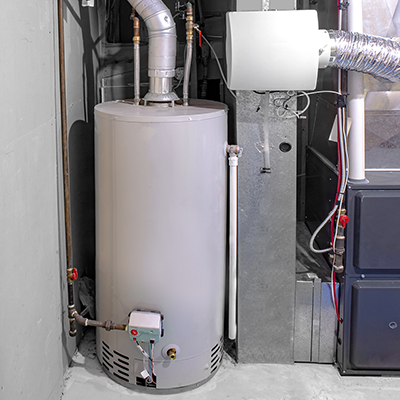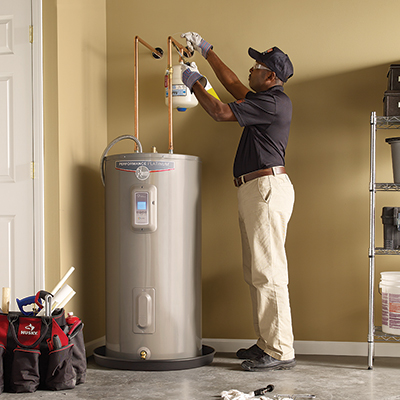How to Install a Gas Water Heater

Last updated October 6, 2023
Water heaters are appliances that supply hot water to your home, but they don’t last forever. Many water heaters have an estimated life expectancy of 8 to 12 years. To replace a failing gas water heater or install a new one, you need a gas supply line, a cold-water supply line and a flue connection to divert harmful combustion gases. This guide explains how to install a gas water heater tank in your home.
Gas water heaters include a tank, dip tube and discharge pipe; gas burner and assembly; an exhaust flue; a pressure release valve; and a drain valve.
Note: Tankless gas water heaters have different installation demands. Be sure to check your owner’s manual for your model's requirements.
Difficulty:
Advanced
Duration:
2-4 hours
Table of Contents
Before Installing a Gas Water Heater
Drain the Tank
Disconnect the Gas and Water Lines
Detach the Gas Exhaust and Remove the Water Heater
How to Install a Gas Water Heater
Install the Heat Trap Fittings and Water Line Connections
Before Installing a Gas Water Heater
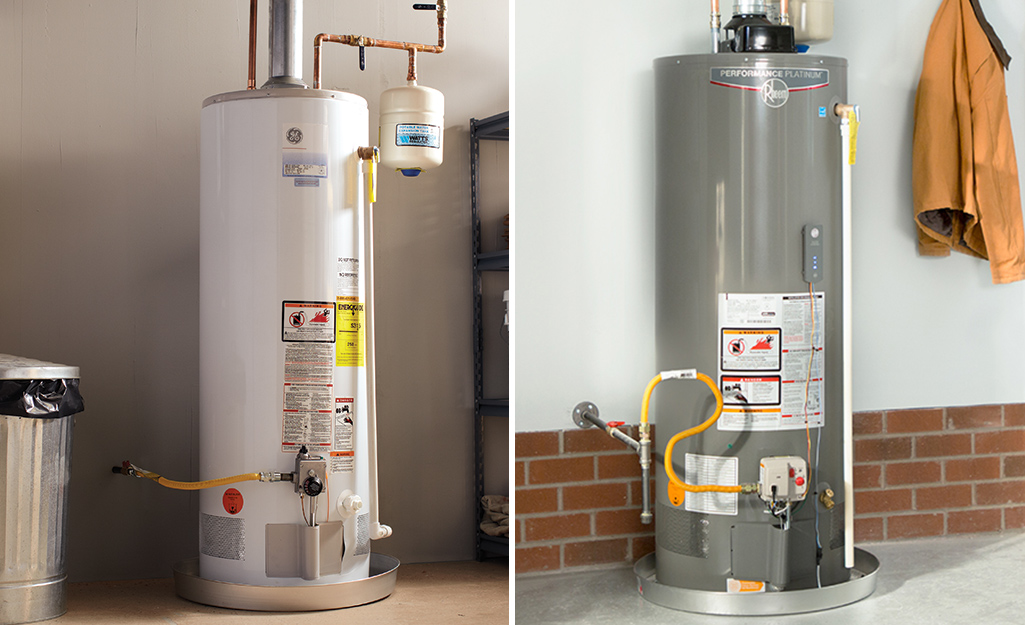
Replacing tank-type gas water heaters require making connections to gas piping and combustion gas venting. Unless you are very familiar with how to make gas line connections and work with vent connections, we highly recommend calling a professional plumber to do this work. Learning how to replace a gas water heater can be very dangerous. Schedule an appointment with our water heater installation services team today.
- Check the labels on the old tank for size and energy specifications before buying a new one. Water heaters manufactured after 2015 meet new energy code requirements. These tank type water heaters have more insulation in them. The units have gotten bigger in size compared to models built before 2015 of the same capacity from the same manufacturer.
- Measure the area where the old water heater fits. If your current water heater was manufactured prior to 2015, check the specs of the new model and make sure it will fit in the current space.
- Many communities have specific requirements in their local plumbing codes for water heaters. Confirm your installation will comply with water heater installation code mandates for your location and water heater type.
- Tools needed to install a new gas water heater: adjustable wrenches, drills, gloves, hand truck, pipe cutter, pipe wrenches, safety glasses and screwdrivers.
- Materials needed to install a new gas water heater: buckets, discharge pipe, drain pan, gas leak detection solution, gas water heater, gas water heater flexible hose kit, garden hose, matches, plumber's tape, pressure gauge, pressure reducing valve, plumbing pipe and fittings, thermal expansion tank/pressure tank, tire gauge, vent pipe.
Drain the Tank
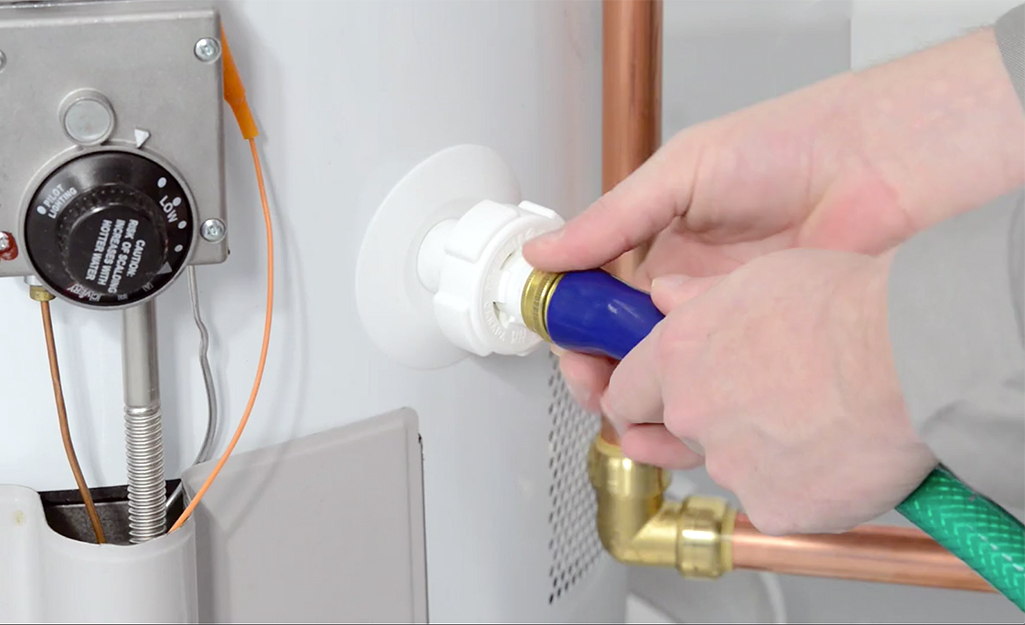
When installing a gas water heater, begin by draining the old water heater tank.
- Turn off the water supply to the water heater. Also turn the control valve to “off” on the water heater. Then turn off the gas supply valve to the water heater.
- Turn on the nearest hot water faucet and allow it to run until the water runs cool. This safely drains the unit without worrying about hot water. Keep this faucet open as it will allow the tank to drain faster.
- Attach a garden hose to the drain valve. Empty the tank either into buckets, a floor drain, a sink in the basement or an appropriate place outside. If you choose to drain the tank while the water in it is still hot, use extreme caution. Use a hose rated to withstand heat.
Disconnect the Gas and Water Lines
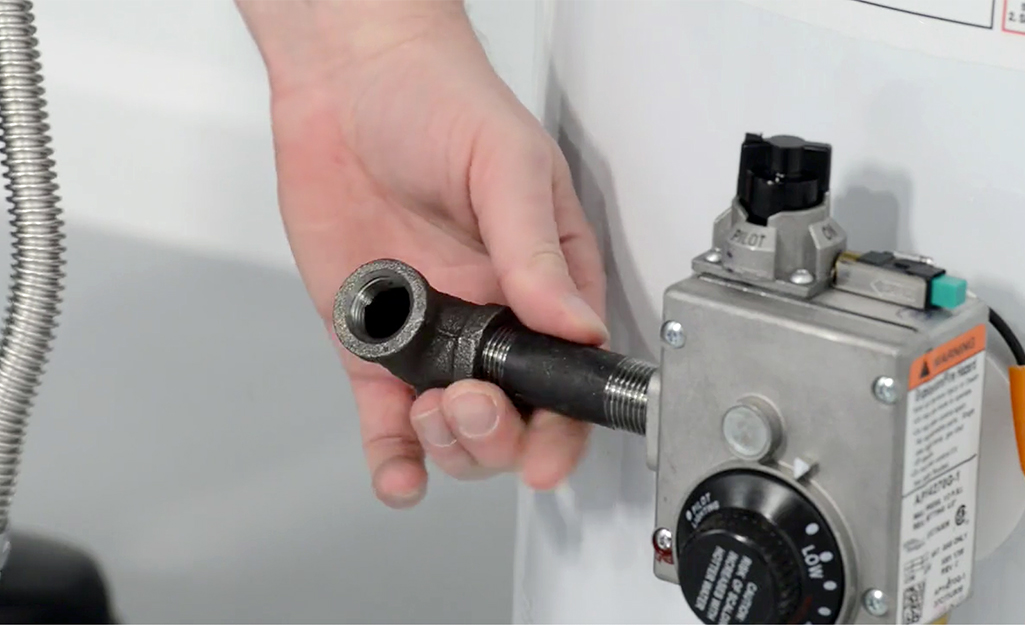
Next, detach the gas and water lines from the old water heater.
- After confirming that the gas supply is shut off, disconnect the gas line using two pipe wrenches. Disconnect the gas line at the union fitting if the gas supply line is a black iron pipe. Disconnect at the flare fitting if the gas supply line is a flexible pipe. The union fitting is typically installed just after the gas valve that feeds the water heater.
- Using two adjustable wrenches or pipe wrenches, disconnect the water lines above the tank. If the piping has been soldered into place, use a tubing cutter to cut the pipe. Clean the pipe with a sanding cloth before cutting the pipe. This will make it easier to prep for the solder connection later.
- Remove any gas piping that is attached to the old water heater’s gas valve. If the supply here is made of black iron pipe, keep the tank tee and sediment trap intact. Keep the leg that connects to the union so you can re-use them later.
- Remove the overflow pipe and pressure release valve from the old hot water heater. You will reinstall it later on the new unit.
Detach the Gas Exhaust and Remove the Water Heater
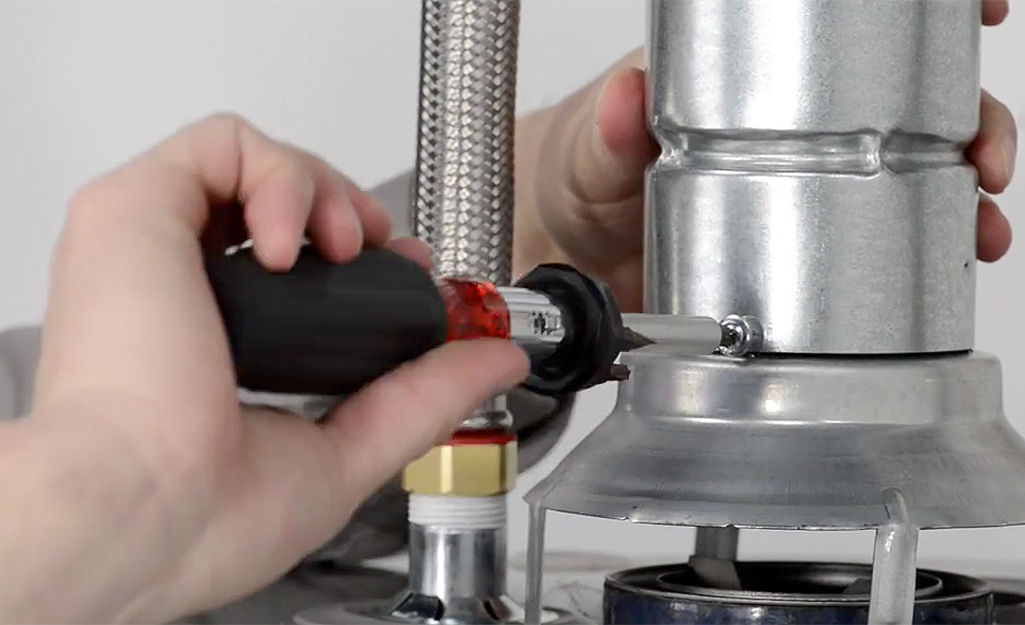
The final step before replacing a gas water heater is to detach the gas exhaust from the vent hood. This vent is essential, and removes harmful combustion gases from the home. These gases contain carbon monoxide.
- Remove the screws connecting the vent pipe to the water heater using a screwdriver or nut driver.
- Leave the old venting in place but check for rust or damage. Replace the flue pipe if it is in poor condition.
- Remove the old water heater. Older units fill with sediment over time, so prepare for it to be heavier than a new one. You may need a helper and an appliance dolly.
- Dispose of your old water heater. Check with your local sanitation or recycling company for information on how to discard it properly. When using a professional installer, make sure they remove the old water heater as part of their service.
- Clean the floor where the old water heater stood.
How to Install a Gas Water Heater

Now you’re ready to begin installing the gas water heater. Whether you’re replacing an old water heater or installing a new one from scratch, make sure it will have at least 6 inches of clearance on all sides. This will help ensure adequate ventilation.
- Align the water heater so there’s easy access to the burner and controls. Follow the manufacturer’s guidelines and local water heater installation code requirements. The location must meet minimal clearances for combustible materials.
- Use a carpenter’s level and plastic shims to level the water heater as needed.
- Connect the flue hat to the gas exhaust vent with a screwdriver. New hot water heaters 55 gallons and larger are more efficient and cannot be vented into a chimney. These units must be vented directly to the outside using non-metallic plastic vent pipe. If you have to replace this size tank, follow the manufacturer’s guidelines for venting.
Tip: Stand the water heater in a drain pan that will catch water and run a line to a nearby floor drain in case it ever leaks.
Install the Heat Trap Fittings and Water Line Connections

Next, attach the heat trap fittings and water line connections. Heat trap fittings improve your water heater’s efficiency. They prevent hot water from leaving the tank and stop cold water entering when it’s not in use.
- Wrap the heat trap fitting pipe threads with thread seal tape. Many of these fittings are directional. Find the arrows that show the correct direction for installation. If installed wrong, water will not flow properly or at all.
- Attach the blue-coded fitting to the cold-water inlet. Follow the arrow facing into the water heater.
- Attach the red fitting to the hot water outlet. Follow the arrow pointing away from the water heater.
- Tighten using a pipe wrench or adjustable pliers.
- Measure and cut the water line connections to length as needed.
- When sweating the remaining copper sections, dry fit everything first. Sweat any threaded copper fitting first. Let them cool before installing them onto the heat trap fittings. Once you have the pieces in place, separate the parts. Clean the inside of each joint and the end of each section of pipe. Use a sanding cloth or a pipe fitting brush to do this.
- Apply flux to the fittings and pipe. Assemble and solder using a propane torch.
- Reconnect the water line.
- Attach the pressure relief valve. Wrap the threads with thread seal tape, then screw it onto the new tank.
- Install the valve’s drain line from the previous tank. Wrap the threads with thread seal tape and install it onto the valve.
Tip: We recommend professional installation if you must have soldered fittings. You can also opt for water heater supply lines in lieu of making sweat connections. Some of these options contain push-to-connect fittings or compression fittings.
Connect the Gas Supply
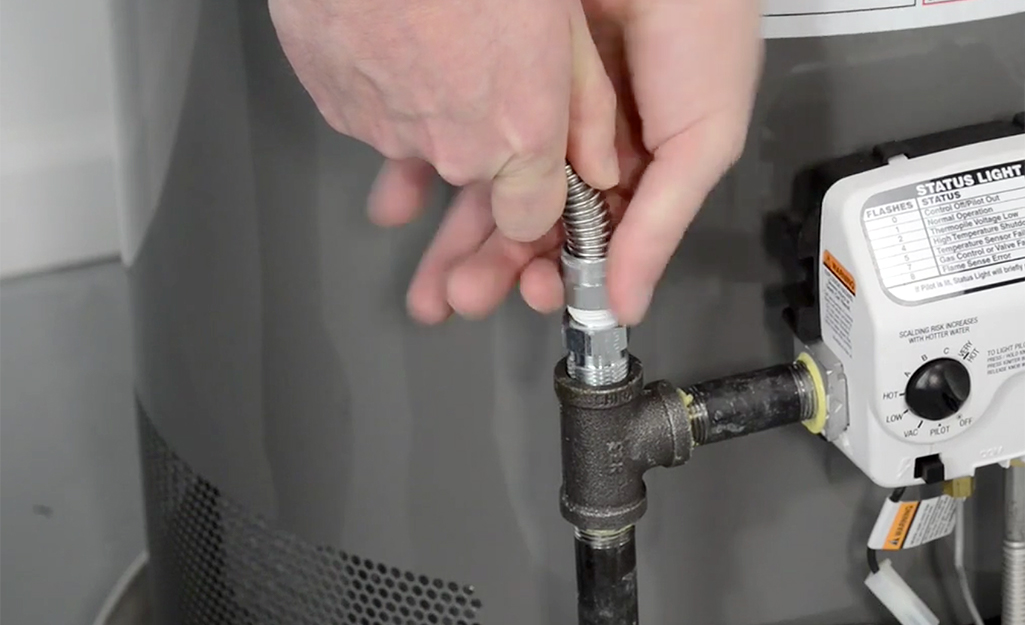
Next, attach the water heater parts that connect the gas supply line.
- Before connecting the gas line, clean all threads with a wire brush and rag.
- Apply gas-rated thread seal tape or piping compound to the threads of the black pipes as you connect them. If you are not familiar with connecting black iron pipes, there are gas water heater installation kits available. If using a kit, follow the manufacturer’s guidelines.
- Assemble and tighten each fitting with two pipe wrenches.
- Install the union fitting last since it connects the new line to the existing line. Apply gas-rated pipe joint compound to the union’s flare connection.
- Turn on the water supply. Open the water valve at the tank to fill the tank with new water. Turn on one or more hot water faucets to bleed air out of the system.
Tip: If required by code, attach seismic straps that hold the water heater in place. This helps avoid earthquake damage.
Test the Gas Line for Leaks
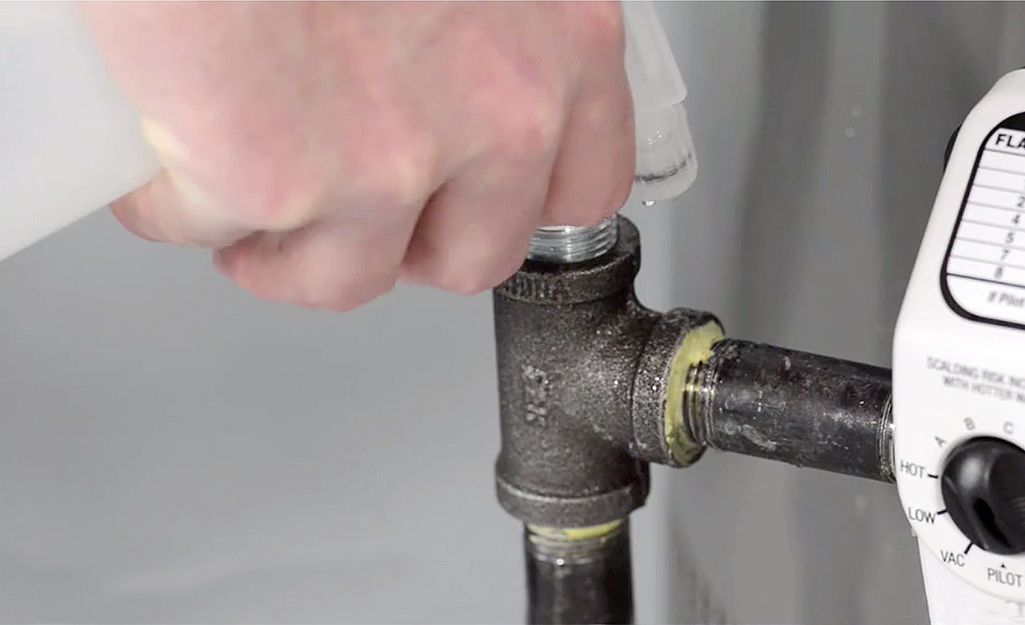
Stay safe and test the gas line for leaks before going further.
- As the tank fills, open the gas supply valve and check for leaks using a gas leak detection solution. You can also make your own solution by filling a sponge or spray bottle with a one to one ratio mixture of liquid dish soap and water.
- Apply the solution to the new fittings. Check for bubbles.
- Test all connections. If there’s a leak, bubbles will form on the surface and you’ll have to tighten or refit the joint.
Light the Pilot and Turn the Control Knob On
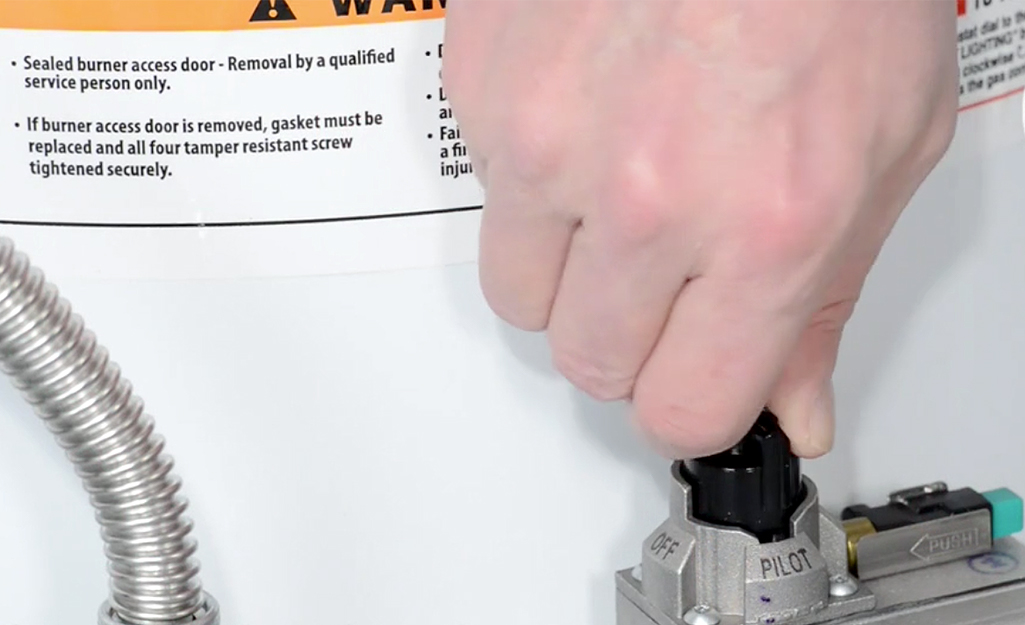
Most new water heaters have a built-in ignition switch to light the pilot. Refer to the owner’s manual for more details. If your unit is not equipped with an ignition switch, follow these steps:
- Remove the burner access panel.
- Turn the knob on top of the control box to the pilot position.
- Hold a lit fireplace match or barbecue lighter to the pilot access opening.
- Press and hold down the reset button on the control box for 60 seconds after the pilot ignites.
- Turn the knob on top of the control box to the “on” position. You should hear the burner ignite.
- If it doesn't, remove the access panel and relight the pilot.
- Replace the burner access panel and set the control at a temperature between 118 and 123 degrees.
When installing a gas water heater, make sure it is venting properly. Close windows and doors and turn on the nearest hot water faucet. When you hear the water heater’s gas burner ignite, wait one minute and then move a smoking match near the edge of the draft hood. If the smoke doesn’t draw up the vent pipe, the fumes are not venting properly. In this case, open all windows and doors immediately and contact a professional to inspect and fix the venting.
Learning how to install a gas tank water heater can be a challenging process. Do not attempt installing a gas water heater yourself unless you’re experienced and comfortable with soldering, working with natural gas and following local installation codes. Save yourself the hassle with our gas water heater installation services which include removal of the old water heater.
Related Products
Related Guides
Leave Your Next Project to Us
Professional Water Heater Installation
- Expert Water Heater Installers Do It For You
We hand-select licensed and insured water heater specialist in your area who are known for their experience, knowledge, and superior service.
- How Our Water Heater Installation Works
Start by requesting a free consultation to explore options for installing or replacing your water heater. A local, certified water heater expert will contact you to evaluate your current system and recommend solutions tailored to your needs and budget. They will then perform a detailed in-home inspection and provide a final quote. Once you decide to proceed, they will schedule a convenient installation date and handle the entire process—including testing the new unit and disposing of the old one—typically within a single day.
